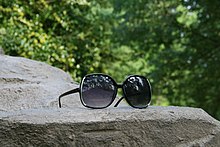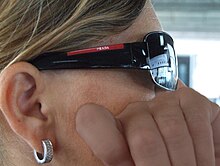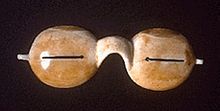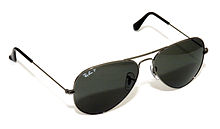sunglasses
A sunglasses is a goggles whose tinted lenses reduce the light transmission to the eye of the wearer. Their primary purpose is to protect the eyes from the unpleasant or harmful effects of sunlight . The optimal sunglasses therefore also block the ultraviolet radiation component of the sunlight and reduce the incidence of stray light due to their lens size and shape as well as an optimized glasses frame. In addition, as clothing accessories, sunglasses fulfill image and fashion aspects at the same time.
Protective function
Sunglasses are usually worn to protect the eyes from light. Other reasons, however, can be fashion consciousness, shielding the eyes from the looks of others, etc.
Often, only the lenses are wrongly regarded as important for the protective function. However, the design of the glasses is also important: some glasses allow up to 60 percent of the sunlight to fall behind the glasses from the side or from above and below (scattered light). Good protective glasses leave only the smallest possible gap between the glasses and the wearer's head, but without being so close that the glasses are touched by the eyelashes . Scattered light is blocked on the sides by wide temples or by glasses that bend around the head.
tint
Sunglasses reduce the visible light by tinting their lenses and thus protect against brightness and glare; that is, they darken the environment visibly for the wearer of glasses. This can improve visual performance in bright light. Depending on the intended use (light sunshine in the city to strong sunlight on the glacier) and the wearer's sensitivity to light, different degrees of tint are possible. The tint and its thickness have nothing to do with the UV protection or the color of the lenses.
There are five filter categories for sunglasses with regard to the tint:
- Category 0
- <20% tint
- very limited attenuation of solar radiation
- Category 1
- 20-57% tint
- for overcast days
- Category 2
- 57-82% tint
- normal glare protection for summer days in Central Europe
- Category 3
- 82-92% tint
- for water surfaces, beaches and mountains as well as southern European countries
- Category 4
- 92-97% tint
- for high mountains and glaciers; not suitable for road traffic
With some sunglasses, an additional selective light reduction is achieved through polarization filters (see the section on lens properties and finishes ).
Protection against ultraviolet radiation (UV protection)
In addition to the light that is visible to humans, sunlight also contains UV light that is invisible to humans , which can be divided into UV-A, UV-B and UV-C. It is generally claimed that greater intensity or prolonged exposure to UV light can cause eye irritation, cataracts and even blindness . Even when the sky is overcast, UV light can be dangerous. However, there are no clinical studies on this and the information on duration and intensity are vague and not regulated by law.
Depending on the type of lens, glasses can offer more or less UV protection. UV protection is particularly important for sunglasses because the pupils of the eyes widen (or narrower less) when they are darkened by the sunglasses and therefore more UV light falls on the retina than without sunglasses. A lens with optimal UV protection blocks all wavelengths below 400 nanometers (UV-A, -B, -C).
Since UV light is not visible, the protection factor of glasses cannot be seen with the naked eye. Tests of spectacle lenses for adequate UV protection are only possible with the appropriate equipment and are therefore usually only carried out by the manufacturer or some opticians; Sufficiently UV-protected glasses are therefore often marked with a sticker "UV 400". In addition, several international standards, including an inadequate EU directive, allow the UV protection of eyeglass lenses to be classified (see below ).
Blue component of the light
In bright light conditions (sunlight), the blue component of visible light is also said to be dangerous, as it can cause damage to the macula ( macular degeneration ) or exacerbate existing damage and ultimately lead to blindness. Some sunglasses therefore also reduce the blue component of visible light. A guideline value of less than 10 percent light transmission between 400 and 470 nanometers is recommended. On the other hand, filtering away the entire blue component leads to distortions in color perception, which is seen as dangerous in road traffic, among other things.
Guidelines or norms are still largely pending in this area, and there is as yet no information on their blue protection for most commercially available sunglasses. Some opticians offer blue protection measurements for glasses. An exception is Switzerland , where the importance of blue protection was recognized and reacted to earlier.
Further protection
Depending on the intended use, sunglasses can also offer additional protection. For example, some water sports enthusiasts use sunglasses to protect against splashing water. For cyclists, the protective effect against wind and flying insects is also beneficial. Astronaut sunglasses are specially designed to protect against infrared light .
Sunglasses, even with adequate UV or blue protection, are not suitable for direct observation of the sun , not even for looking directly into lamps with high luminance, as protection from UV light sources (solariums, sunlamps ) or for protection during welding work . Special solar observation filters or solar filters , solar eclipse goggles and welding goggles or masks are to be used for this.
Standardization (primarily UV protection)
There are three standards for sunglasses worldwide: Australian, European and US standards. They are best known for their standardization of UV protection, but also affect other properties of sunglasses. Blue protection and protection against stray light have not yet been standardized.
Glasses with a CE mark and the ISO 12312-1 label on the inside of the temple are evidence that the glasses meet the basic safety requirements of international guidelines. However, there is no independent body that checks compliance with each individual model. With well-known manufacturers, consumers can assume that the guidelines are being adhered to, and UV absorption can also be tested by many opticians. The widespread name "UV 400" is not standardized and says nothing about UV protection.
In terms of EC Directive 89/686 / EEC, sunglasses are personal protective equipment. The technical standard for sunglasses for general use is ISO 12312-1: 2013. According to this standard, sunglasses are divided into five filter categories. However, the standard only applies to UV protection up to 380 nanometers - 400 nanometers are medically recommended and internationally used - and protection against blue light ("blue protection") is not covered at all.
| EU category: | Light transmission up to 380 nm : | Description: |
| out of the norm | to 3 % | extremely dark glacier glasses |
| 4th | 3–8% | very dark tinted |
| 3 | 8-18% | dark tinted |
| 2 | 18-43% | medium toned |
| 1 | 43-80% | slightly tinted |
| 0 | 80-100% | colorless or very slightly tinted |
Sunglasses are part of the personal protective equipment for certain professions (for example road foremen , swimming masters , employees in opencast mines and in quarries) and must then be provided by the employer in accordance with occupational health and safety law in the EU. The European standards EN 166 and EN 172 apply to sunglasses and sun protection filters for commercial use.
Glass color
The real glass lenses ( mineral glass ) and plastic lenses ( polyacrylic ) are colored in different colors (brown, green, gray, blue, yellow, red and similar) depending on the function or fashion. The color is usually added to mineral glass when it is melted. Plastic glasses are painted in a dip process. Different colors and color gradients can be generated depending on the manufacturing technology.
Gray is neutral in color. The classic brown coloring causes only a slight color falsification and offers protection against blue light. Green colored glasses are also only slightly color falsified and intensify green colors (plants). Yellow glasses have a contrast-enhancing effect (sport), but are not suitable for road traffic because of their color-falsifying properties. Blue, red and purple colored glasses are fashion items and the protective effect should be clarified with the optician on a case-by-case basis. Gradient tints (the lenses are tinted more strongly in the upper area than in the lower lens area) and reflections from the outside are also possible.
Glass properties and finishes
Eyeglass lenses are made either from real glass (mineral glass) or from plastic. Genuine lens lenses are 50 percent heavier than comparable plastic lenses, but have a comparatively very high resistance to scratches and injuries. Lenses made of plastic are lighter in weight than lenses made of mineral glass and are more break-proof (especially those made of polycarbonate), but also more sensitive to scratches, which is why they sometimes have an additional surface hardening that significantly increases scratch resistance and, depending on the manufacturer, varies greatly. Polycarbonate lenses are mainly used for sports glasses. Plastic lenses offer many more options when it comes to tinting. Plastic glasses contract when exposed to the sun for a long time (e.g. on the window shelf in a car), so that they lose their hold in the frame and can fall out of the glasses. Readjustment is only possible to a limited extent.
In order to optimize the properties of spectacle lenses, they undergo various refinements. Refinements are wafer-thin layers that are applied to the base material and lead to better optical properties. For example, anti-reflective coatings are often used. Anti-reflective lenses are more translucent, reduce light reflections very strongly and thus enable clearer or more relaxed vision than with non-anti-reflective glasses (important for drivers in oncoming traffic and for the least possible disruption from street lighting). Mirror coatings (in silver or gold) reinforce (on the outside of the glass) the surface reflections and improve glare protection. Hard layers or seals (easier cleaning) are also among the finishes.
Polarizing glasses can filter out reflected and possibly blinding light - from non-metals - if their polarization planes are normal to each other. As long as the head is only raised or lowered, but not tilted to the side, the glasses and their polarizing filter level remain horizontal. The glasses then extinguish those vertically polarized parts of the light that ideally arise when the sun is halfway up in front of you and hits horizontal mirror surfaces such as water, glass, snow crystals, sand, paint, etc. at Brewster's angle and as Mirror image from diagonally below is dazzling. The strength of the effect depends on the angle of incidence of the sun and the uniformity of polarization in the reflected light.
Darkening glasses
Photochromic glasses darken themselves with increasing UV radiation and depending on the temperature. The phototropy is based on a reversible transformation of deposited silver halide-containing precipitates. Different colors can be produced depending on the type of halide in the glass. Brown or gray photochromic glasses are used for the production of sunglasses, which automatically become darker (quickly) when the brightness is high, and more transparent again when the brightness decreases (more slowly). The difference in speed is due to the fact that an equilibrium is established between two opposing reactions: Darkening takes place in a zero order reaction (every incident light quantum with a suitable wavelength causes a molecular transformation). In contrast, the reverse process is a first-order temperature-dependent reaction that proceeds according to an exponential function (equal proportions react in the same times; compare half-life ). When it is very cold and bright (in winter, in snow), the glasses are tinted; it becomes clear with decreasing UV radiation, whereby this effect can be accelerated under warm water. There is also the model of continuously adjustable sunglasses based on two mutually adjustable polarization filters .
Solutions for wearers of corrective glasses
A sun clip can be used especially for people with poor eyesight. This means that corrective glasses can easily be upgraded to sunglasses. The advantage of the sun clip is that you don't have to buy additional sunglasses with diopters, instead the sun clip is put on your own glasses. One disadvantage, however, is the poor shielding. As explained above, good sunglasses should be close to the head and prevent light from falling from the side. Since only a few glasses can do this, the sun clip also has a weak point here. Another disadvantage arises from the additional reflections on the surface of the clip.
Overspecs that can be worn over corrective glasses are a better solution in this regard. These can also be put on and taken off more easily, for example when entering darker rooms, driving through tunnels or similar situations in which sunglasses are not required.
As a further alternative, some sunglasses suppliers offer corrective clips that can be used to attach (clear) corrective lenses to the inside of the sunglasses.
Ultimately, however, the most widespread possibility is to provide sunglasses with the correction of an existing visual impairment, i.e. to make sunglasses with tinted corrective lenses. On the one hand, this has the advantage that no further reflective surfaces are introduced into the field of view, as would be the case with a sun clip, for example. These have a negative effect on the image quality. On the other hand, glasses designed as sunglasses with appropriate correction often have a more aesthetically pleasing and natural effect than solutions made from different components. In addition, almost any eyeglass lenses available on the market with tints of different intensity and color can be ordered from the industry and non-coated lenses (without anti-reflective coating etc.) can even be colored by the optician himself.
Further use
Sunglasses are also often worn by people suffering from blindness or other eye diseases to cover up their eyes or to protect them from bright light if they are very poorly able to see and have sensitive eyes.
Well-known personalities such as Ray Charles , Bono or Heino made sunglasses their trademark.
In the 1980s and 1990s in particular, sunglasses became a fashion accessory that was also worn where it initially seemed impractical; for example during a nightly disco visit. Due to the impossibility of direct eye contact, the sunglasses stood for aloof and superior coolness . This image was cultivated especially in movies like Blues Brothers or Men in Black . The new-wave singer Corey Hart brought this trend in his song Sunglasses at Night expressed and carried himself to gigs sunglasses.
It is difficult to identify people with sunglasses by a cursory glance and to recognize their direction of vision. For these reasons, wearing sunglasses is attractive for certain professional groups.
Sunglasses are also used in sports. Ski goggles are particularly common.
history
Against snow blindness already used the Inuits early bone or wooden boards with fine view slots (see snow goggles ).
Sun protection for the eyes was an issue even in ancient Rome . Emperor Nero (37 to 68 AD) observed gladiator fights to protect against bright sunlight through green emeralds .
In the 15th century, glasses were provided with colored glasses against the glare effect of the sun. In 1752, designer James Ayscough introduced smoked glasses. At least in terms of shape, Ayscough's design was a light protection for the eyes that was similar to today's glasses. Many original glasses of various designs (made of single lenses) with yellow, green, blue or red lenses from the 18th century are still preserved. With fabric and leather, additional scattered light was already kept from the side of the eye on some models. In 1797 the Englishman Richardson developed glasses with which additional green glasses could be flipped over the side of the glasses.
The French doctor Jean-Marie-Théodore Fieuzal (1836 to 1888) pointed out the harmful UV rays and recommended using yellow instead of blue glasses to protect against them. In the 19th century, the Königsberg optician Christian Parschin received the patent for amber glasses. A study by the Swiss Alfred Vogt demonstrated the harmful effects of UV radiation in 1908. But as early as 1905, Josef Rodenstock developed the first glasses that effectively filtered out the UV component of light. And at the beginning of the 20th century, the Schott company launched protective glasses with different tints under the umbrella name . The Nitsche & Günther factory from Rathenow became a first market leader in this new branch of industry.
From 1930 onwards, Bausch & Lomb , an American manufacturer of optical devices, began producing protective glasses in series. The first sunglasses from this manufacturer followed in 1934. The model called Aviator was introduced to the general public in 1936. In 1937, the subsidiary Ray-Ban was founded, which only dealt with sun protection glasses. The Wayfarer sunglasses, designed in 1952, offered a trapezoidal frame made of plastic that was new for the time and gained general notoriety through stars such as Buddy Holly, Marilyn Monroe, James Dean, Roy Orbison and their appearance on Audrey Hepburn's nose in Breakfast at Tiffany’s . Both models, the Aviator and the Wayfarer , are still in production today and are considered fashion classics and the best-selling sunglasses models in the world. In Germany, the Zeiss company offered its Umbral sunglasses immediately after the end of the war .
Polarization glasses were first used as protective glasses shortly before the Second World War (manufacture of the polarization filter by Erwin Käsemann 1937). Since the late 1930s, more and more medical professionals have been pointing out the dangerous effects on the eyes of excessive sunlight. Since then, fashion aspects have also contributed to the increasing acceptance of sunglasses in society. The sunglasses increasingly became a branded and mass-produced item. A sunglasses boom began. The first photochromic glasses were introduced in the mid-1960s. In 1986, the Rodenstock company presented a tinted plastic glass.
literature
- Karin Hartewig: The veiled look. A brief cultural history of sunglasses. Jonas Verlag, Marburg 2009, ISBN 978-3-89445-416-6 .
Web links
- Cantonal Laboratory Baselland: The right sun protection for the eyes
- How sunglasses work. (engl.) ( How Stuff Works )
- Current standardization of sunglasses. In: intertek.com
Individual evidence
- ^ Siegfried Hünig (2008): Optimized light protection of the eyes. An urgent task and its solution. Part 1: Nature of light, internal and external defense mechanisms. In: Journal for practical ophthalmic medicine, 29 , pp. 111–116 (PDF file; 874 kB).
-
↑ a b c d Siegfried Hünig, in consultation with Albert J. Augustin (Oct. 2007). Prevent and alleviate visual damage in old age. Information and recommendations on age-related macular degeneration and cataracts. ( Memento of the original from July 4, 2015 in the Internet Archive ) Info: The archive link was inserted automatically and has not yet been checked. Please check the original and archive link according to the instructions and then remove this notice. Manuscript from the website of the Karlsruhe Clinic , accessed on May 28, 2011.
Siegfried Hünig (2008): Optimierter Lichtschutz der Augen. An urgent task and its solution. Part 1: Nature of light, internal and external defense mechanisms. In: Journal for practical ophthalmic medicine, 29 , pp. 111–116 (PDF file; 874 kB).
Siegfried Hünig (2008): Optimized light protection for the eyes. Part 2: The visual process as a risk factor, light protection through glasses. In: Zeitschrift für Praxis Augenheilkunde, 29 , pp. 197–205 (PDF file; 874 kB).
- ↑ Sunglasses lenses: ISO norm and UV400 specification. In: eyeglass24.de .
- ↑ Photochromic glasses. Perret Optometrist, accessed June 9, 2013 .
- ↑ derStandard.at The sunglasses - a brilliant invention?
- ↑ Patent DE 755 488 C




